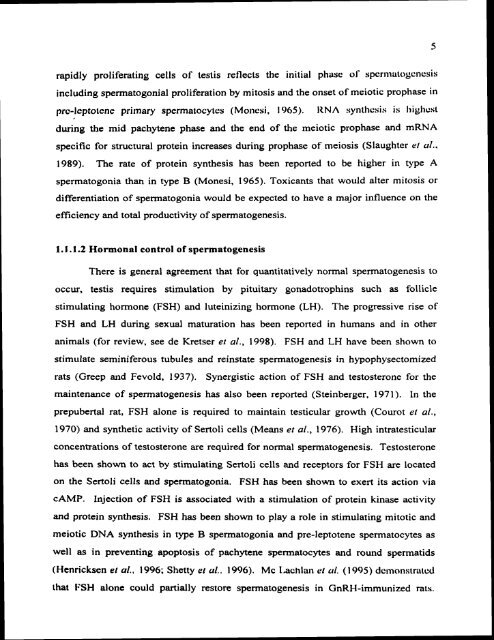ON TESTIS AND EPlDlDYMlS OF RATS - Pondicherry University ...
ON TESTIS AND EPlDlDYMlS OF RATS - Pondicherry University ...
ON TESTIS AND EPlDlDYMlS OF RATS - Pondicherry University ...
You also want an ePaper? Increase the reach of your titles
YUMPU automatically turns print PDFs into web optimized ePapers that Google loves.
apidly proliferating cells of testis reflects the initial phase ol' sper~iiiltoycncsis<br />
including spermatogonial proliferation by mitosis and the onset of meiotic prophase in<br />
prc-leptotcne primary spermatocylcs (Monesi, 1965). ItNA synthesis is highost<br />
during the mid pachytene phase and the end of the meiotic prophase and mRNA<br />
specific for structural protein increases during prophase of meiosis (Slaughter el 01..<br />
1989). The rate of protein synthesis has been reported to be higher in type A<br />
spermatogonia than in type B (Monesi, 1965). Toxicants that would alter mitosis or<br />
differentiation of spermatogonia would be expected to have a major influence on the<br />
efficiency and total productivity of spermatogenesis.<br />
1.1.1.2 Hormonal control of spermatogenesis<br />
There is general agreement that for quantitatively normal spermatogenesis to<br />
occur, testis requires stimulation by pituitary gonadotrophins such as follicle<br />
stimulating hormone (FSH) and luteinizing hormone (LH). The progressive rise of<br />
FSH and LH during sexual maturation has been reported in humans and in other<br />
animals (for review, see de Kretser et ul., 1998). FSH and LH have been shown to<br />
stimulate seminiferous tubules and reinstate spermatogenesis in hypophysectomized<br />
rats (Greep and Fevold, 1937). Synergistic action of FSH and testosterone for the<br />
maintenance of spermatogenesis has also been reported (Steinberger. 1971). In the<br />
prepubertal rat, FSH alone is required to maintain testicular growth (Courot el al.,<br />
1970) and synthetic activity of Senoli cells (Means et al., 1976). High intratesticular<br />
concentrations of testosterone are required for normal spermatogenesis. Testosterone<br />
has been shown to act by stimulating Senoli cells and receptors for FSH are located<br />
on the Senoli cells and spermatogonia. FSH has been shown to exert its action via<br />
CAMP. Injection of FSH is associated with a stimulation of protein kinase activity<br />
and protein synthesis. FSH has been shown to play a role in stimulating mitotic and<br />
meiotic DNA synthesis in type B spermatogonia and pre-ieptotene spermatocytes as<br />
well as in preventing apoptosis of pachytene spermatocytes and round spermatids<br />
(Henricksen el ul.. 1996: Shetty el ul.. 1996). Mc lachlnn el ol. (1995) detnonstrntod<br />
that FSH alone could partially restore spermatogenesis in GnRH-immunized rats.

















